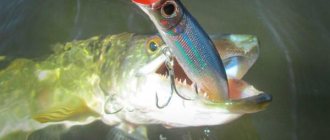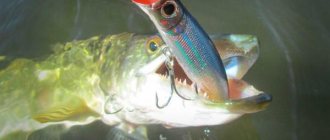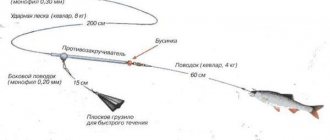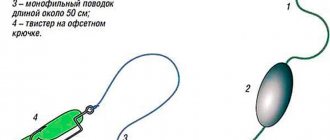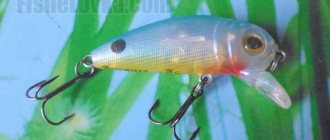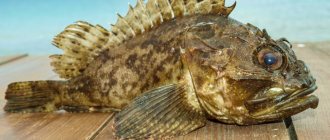Beluga fishing
Beluga is a fish of the sturgeon family, included in the Red Book. This is an anadromous fish that lives in the Caspian, Azov and Black Seas, from where it comes to spawn in the Volga, Ural, Kura, and Terek. In the past, when there were no hydroelectric power stations, fish rose very high in the Volga basin - to Tver and the upper reaches of the Kama, and in the Urals they spawned mainly in the lower and middle reaches. Beluga was also found along the Iranian coast of the southern Caspian Sea and spawned in the river. Gorgan. The Azov beluga enters the Don and Kuban. Previously, this fish rose high along the Don, but now it only reaches the Tsimlyansk hydroelectric station. The main part of the Black Sea beluga population, both in the past and now, lives in the northwestern part of the sea, from where it goes to spawn in the Danube, Dnieper and Dniester; single individuals used to enter (and perhaps are now entering) the Southern Bug.
Beluga was also found along the Crimean coast, near the Caucasian coast, where it sometimes went to spawn in Rioni, and along the Turkish coast, where it entered the Kyzylyrmak and Yesilirmak rivers to spawn. Along the Dnieper, large individuals (up to 300 kg) were sometimes caught in the area of rapids, and extreme occurrences were noted near Kyiv and higher: along the Desna, beluga reached the village of Vishenki, and along the Sozh - to Gomel, where in the 1870s. an individual weighing 295 kg (18 pounds) was caught. The main part of the Black Sea beluga goes to spawn in the Danube, where in the past this species was quite common and rose as far as Serbia, and in the distant past reached the city of Passau in eastern Bavaria. Along the Dniester, beluga spawning was observed near the city of Soroca in the north of Moldova and above Mogilev-Podolsky. Along the Southern Bug the fish rose to Vozne Seneca (northern Nikolaev region). Currently, the Black Sea beluga population is on the verge of extinction. Until the 70s. XX century Beluga was also found in the Adriatic Sea, from where it entered the Po River for spawning, but over the past 30 years it has never been seen here, and therefore the Adriatic population of beluga is currently considered extinct.
Beluga is a predator that feeds mainly on fish, which begins to lead a predatory lifestyle while still young in the river. In the sea, beluga also feeds mainly on fish (herring, sprat, gobies, etc.), but does not neglect shellfish. Even baby seals were found in the stomachs of Caspian beluga.
Beluga is a long-lived fish, reaching an age of 100 years. Unlike Pacific salmon, which die after spawning, beluga, like other sturgeon, can spawn many times in their lives. After spawning, it rolls back into the sea.
Beluga is one of the largest freshwater fish, reaching a mass of 1000 kg and a length of 4.2 m. There is information about a beluga caught in 1827 in the lower reaches of the Volga, which weighed 1.5 tons (90 pounds). In the Caspian Sea near the mouth of the Volga on May 11, 1922, a female weighing 1224 kg (75 pounds) was caught, with 667 kg on the body, 288 kg on the head and 146.5 kg on the eggs. Large specimens were also found in the southern part of the Caspian Sea. Thus, in 1836, a beluga weighing 960 kg (60 pounds) was caught near Krasnov on the Decoy Spit (modern Turkmenistan). Later, fish larger than a ton were no longer recorded, but in 1970 a case was described of catching a beluga weighing 800 kg in the Volga delta, from which 112 kg of caviar was extracted, and in 1989 a beluga weighing 966 kg and length 4.2 m (currently her stuffed animal is kept in the Astrakhan Museum)
Beluga caviar
Black caviar. Although this is conditional - it is faster dark gray. Moreover, it has a specific taste, reminiscent of nuts.
Caviar has different levels of “blackness”. The lighter it is, the more expensive it is. The lightest is that of the albino beluga. Moreover, older individuals are more refined, with refined taste. In its white color, golden glimpses can be traced - there are more of them the older the fish is.
Beluga caviar is “willful” - if it comes into contact with metal utensils, it will lose its taste. Beluga caviar has long been served with vodka and champagne. Moreover, the drink should be as cold as possible.
Beluga caviar is one of the largest sturgeon caviar. It reaches a diameter of 6 mm. The price depends on the latter. It also depends on the maturity, on the part of the reservoir where the fish was caught. The highest cost of caviar is from belugas living in the Caspian Sea.
Composition of beluga caviar
There are vitamins, magnesium, phosphorus, molybdenum, calcium, iron, sodium, fluorine. All these substances are beneficial for humans, supporting their health, beauty of their skin and body. In addition, a fifth of it is protein, and one that is completely and easily absorbed by the body.
Caviar is not as fatty as that of other fish from the sturgeon family. However, it is full of Omega-3 fatty acid, which is involved in intercellular processes occurring in the human body. Due to its antioxidant and anti-inflammatory properties, it reduces the likelihood and consequences of heart attack and stroke.
The benefits of beluga caviar
Used in diet. It is prescribed for gastrointestinal diseases. Used as a prophylactic that can help the heart. All this is available to those who are able to buy it. The rest may, due to the scarcity of the product, not see it in their lifetime.
Beluga caviar contains more calories (250 kcal) than its meat (150 kcal).
Contraindications to consuming beluga caviar
There are no prohibitions on use. The only reason not to eat it, besides the fabulous price for most compatriots, is the body’s intolerance to the product.
Beluga caviar price
She is very expensive, but the most expensive of all is the albino beluga. How high the cost can be understood from the fact that it is packaged in gold jars. And such a jar, which does not contain more than 100 g, costs approximately 2 thousand dollars. A kilogram of product costs 23 thousand dollars.
Caviar from regular belugas is cheaper, but most Russians cannot afford it. Cost per kilogram is 10...19 thousand dollars. This variation depends on the shade of the product and the age of the fish.
Is it possible to catch
Catching, transporting, buying, selling and storing animals, including aquatic creatures listed in the Red Book of the Russian Federation, is prohibited by law . Article 258.1 of the Criminal Code of the Russian Federation provides for punishment for this in the form of compulsory labor for a period of up to 480 hours, corrective labor for a period of up to 2 years or forced labor for a period of up to 4 years, and a fine of up to 1 million rubles.
If a fisherman accidentally catches a rare fish listed in the Red Book on a fishing rod, in his hands, or in any other way, he is obliged to release it. If we are talking about reservoirs for sport fishing, then the same rule applies to them.
The caught fish must be released, as selling, storing or using it is prohibited by law.
A pond that doesn't bite
Article-interview with Vyacheslav Batyrov about popular situations when fishing on an unknown pond.
It also happens: Feeder equipment for fishing in the current
You come to a pond (200 by 100 meters), previously you only heard that there are fish here, but you don’t know what kind. And yet the task is set - to catch. What and how is up to you to decide. What gear will you need? What bait?
- Let's consider specific, possibly non-standard situations ↓
- There are a lot of small crucian carp (less than 150 g) and top-smelting fish in the pond ↓
- There are large crucian carp in the pond, but not many, and they bite even on a float rod reluctantly ↓
- Lots of small rudd, medium-sized perch, rotan ↓
- Roach, dace, chub (size of individuals up to 200 g) ↓
- Paid pond with carp of different sizes from 1 kg to 5-10 kg ↓
- A wild reservoir with rare carp (specimens over 5 kg are caught on the feeder, crucian carp 100-200 g and bleak up to 100 g) ↓
- What to do if it doesn’t bite at all? We've tried everything possible, but something is missing. What can cause failure? ↓
Where does the beluga live?
Beluga is found mainly in the basins of the Caspian and Black Seas, and sometimes in the Adriatic Sea. To spawn, fish go to rivers that flow into the listed seas - Volga, Ural, Kura, Terek, Don. In the Black Sea, this fish is found off the coast of Yalta, from where it swims to the Dnieper, Danube, and Dniester.
From the coast of Turkey it moves to the Kyzylyrmak and Yesilirmak rivers. But everywhere it does not rise above the built hydroelectric power stations. Due to the massive construction of hydroelectric power stations, spawning sites were inaccessible, which negatively affected the population - because of this, the species is listed in the Red Book.
The species' habitat is limited to the northern hemisphere (Eurasia, North America). A relative of the beluga, the kaluga (Huso dauricus), lives in the Amur River. And although both species belong to the same genus, modern scientists doubt whether they are related.
What do belugas bite on?
Like all sturgeons, the beluga is covered with durable bony plates, has an asymmetrical, shark-like tail and antennae on a long, elongated snout. This is the only sturgeon species that actively eats other fish. The adult sturgeon has few natural predators. However, due to its caviar, the cost of which can reach up to $8,000 per 1 kg, it is actively caught by poachers. All sturgeons are also valuable commercial fish.
Licenses for catching beluga sturgeon as an object of sport fishing are issued in specially designated places in the Caspian Sea from April to May. The fisherman will need a motor boat with special equipment. Beluga feeds 3–5 km from the coastline. Its main food is in the coastal zone. Fishermen determine its feeding areas by the presence of shell rock at the bottom, near which the main prey is located.
In terms of feeding habits, beluga differs from other sturgeons, which feed on invertebrate animals while swimming along the bottom. In the Black Sea they feed on such types of fish as flounder, gobies, and anchovies. In the Caspian Sea - Caspian roach, herring, and local gobies. The species does not gather in flocks, but disperses. In addition, the predator can endure a long period of starvation, so it is not so easy to catch.
Given that the beluga is a predator, the bait will require its natural prey. And it should not be just a piece of fillet, but a fish along with its scales. Length - up to 15 cm. The natural shine of the scales in the sun attracts the attention of a predator. It is recommended to change the bait after 3 throws.
Beluga spawning
The larger the fish, the slower the process of its maturation occurs. Beluga is the largest fish of its family. In addition, the maturation process is also associated with the lifespan of the fish. Beluga whales have a high life expectancy and live an average of 100 years. These two factors directly affect puberty. In beluga it occurs quite late. Females are ready to breed at the age of 17 years, and males a little earlier. However, females will not spawn until they have gained the required body weight. This usually happens by age 25.
On average, a female beluga spawns 8 times in her life. Despite the fact that the beluga lives in the seas, it goes to rivers to spawn and swims vast distances. One fish can travel up to 15 thousand kilometers. For spawning, beluga chooses the mouths of such rivers as the Volga, Danube, Dnieper, and Ural. Any river near the Caspian Sea will be teeming with beluga during the spawning season.
The fish chooses a sandy bottom to spawn. The beginning of spawning coincides with the beginning of spring, because the fish wakes up after hibernation. The female lays about a million eggs, but, unfortunately, only a small percentage of the eggs will grow into full-fledged fish. Eggs are a tasty morsel for other fish.
The fry, which are formed from eggs, choose shallow water for the first days of life. They feed on other fry and grow very quickly. Small fish do not linger in rivers and make their way to the sea. They will live in the sea for the next 20-25 years, until sexual maturity occurs and the females gain the required body weight.
Beluga fishing technique
For equipment, a fisherman needs a fishing rod with a fishing line that can withstand a weight of 200 kg to 1 ton. Although the maximum weight of a female caught on the Volga in 1989 was 966 kg, you need to be prepared to lift a lot of weight. The beluga will bite just like an ordinary fish. You need to wait for light twitches of the rod, and when it bites more powerfully, you can hook. Then the fish will actively “roll” the boat for several hours until it gets tired and floats up.
Given the weight, to lift the fish you may need a mesh lift, which is included in the equipment of the fishing boat. Even when lifted aboard, the fish remains dangerous, as it can sweep fishermen into the water with a blow of its tail. If the fishermen have caught the prey, it is turned over on its back, measured, weighed and released into the water, since the goal of sport fishing has been achieved. As for industrial fishing, it is not carried out on the territory of the Russian Federation.
Video: catching beluga
Considering the weight of the prey, only experienced fishermen can afford sport fishing. At the same time, they will definitely need a powerful reel, circle hooks, a fishing permit and a huge supply of patience.
Interesting facts about beluga
- Beluga can live more than 100 years, which is why it is considered one of the longest-living fish in the world.
- Parents do not care about their offspring. Moreover, they do not mind feasting on their relatives.
- When a beluga goes to spawn, it jumps high out of the water. This is still an unsolved mystery.
- The beluga, like the shark, has no bones, and its skeleton consists of cartilage, which becomes harder and stronger over the years.
- A lot of eggs can be found in the female. Thus, an individual weighing about 1200 kg can contain up to 150 kg of caviar.
- In the Amur River basin there is a similar species - kaluga, which can reach a length of about 5 meters and weigh up to 1000 kg. Attempts by scientists to cross kaluga and beluga ended in nothing.
Sport fishing for beluga. Giant beluga.
Beluga
is a freshwater predatory “monster”. In the nineteenth century, according to unverified data, a huge specimen of this fish species was caught, weighing more than two thousand kilograms and nine meters long. This is the largest fish on the entire planet Earth, living in fresh water. In the last century, there are indeed officially registered cases of catching giants reaching a weight of one and a half tons and a length of five hundred centimeters, and the museums of Astrakhan and Tatarstan have ton specimens of stuffed fish of these fish, reaching more than four meters in length. As soon as the sun warms up the river water in April-May, belugas from the seas rush to enter the rivers to reproduce their own kind; from September to October, belugas will enter the rivers to spawn before winter. The history of past centuries tells about the industrial fishing of beluga in Russia alone, amounting to tens of thousands of tons of fish caught per year. But the widespread industrialization of the economies of states, namely the construction of dams for hydroelectric power stations in the spawning grounds of beluga, led to a catastrophic decrease in the population of this fish. Today Beluga as an endangered species is protected by law and is a fish listed in the Red Book of Russia and the IUCN.
Giant size sturgeon
Beluga itself is a specimen of fish from the sturgeon family of gigantic size. Its main food is fish - roach, gobies, herring. Beluga fish is found mainly in warm seas such as the Caspian, Adriatic, Black, Azov and White seas. At approximately twenty-three years of age, the female beluga can already go to spawn and move to the nearest freshwater rivers. The life expectancy of this fish on average reaches fifty to sixty years; sometimes the fish lives up to a hundred years. An adult specimen grows up to four and a half meters in length and weighs about a ton.
Uncontrolled fishing of beluga has now led to a sharp decline in its population. Today it is caught mainly for the purpose of artificial breeding. Beluga fishing is classified as entertainment, as well as for scientific purposes and artificial propagation of this species.
Sport fishing for beluga
mainly produced in the spring, from April to the month of May, with a license for sport fishing in a special place in the Caspian Sea. Having agreed with specialists in the beluga fishery on a fishing date, armed with powerful fishing gear and specially equipped for fishing, boats and motorboats go out to sea three or five kilometers from the shore to the feeding grounds of this giant fish. As a rule, it is not possible to determine the fishing location in the sea by eye, so the beluga fishing specialists accompanying the fishermen use a large pole to examine the surface of the bottom, find shell rock, drop anchors and the beluga fishing begins.
Interesting behavioral features: feeding, spawning
The peculiarity of giants is that they go to breed twice a year, which happens in the spring and just before autumn. To do this, huge fish travel amazing distances, looking for comfortable conditions - clean water and a large number of aquatic inhabitants, which they will have to feed on throughout the spawning.
What does beluga eat? Giants do not feed, and all aquatic inhabitants who are careless to approach the monster risk quickly ending up in a voluminous stomach. Despite this omnivorous nature, the beluga prefers certain types of fish, these are:
- herring;
- sea goby;
- all types of carp;
- anchovy.
In rivers, giants feed on fish living in fresh waters - crucian carp, roach, rudd. It is not uncommon to encounter a monster feeding on a careless mouse or water rat. There are no known attacks on humans, but this cannot be ruled out. Often, the giant’s own offspring, recently hatched from eggs, are found in the giant’s stomach.
The giants prepare for reproduction over a long period of time; only at the age of 14-18 years are they ready to set off on their first journey, the final stage of which is the spawning of the beluga. At this time the fish already weighs more than a hundred kilograms, and huge schools look colorful during migration.
Interesting! During transitions, the beluga looks forward to the breeding process, and expresses its delight with huge jumps. The spectacle of a fish weighing up to 300 kg literally hanging in the air is incredibly beautiful and mesmerizing. Another feature is that while jumping, the monsters begin to scream, or rather, make piercing loud sounds.
Females, depending on their size, are capable of laying up to several million eggs. The peculiarity of caviar is that it adheres perfectly to hard, smooth surfaces. The clutch is so large that the accumulation of eggs attracts the attention of almost every aquatic inhabitant who strives to taste the valuable product. The caviar babies hatch quickly - within a few weeks you can see a flock heading out to sea. It is not as large as a school of adult fish, but you can count several dozen fry in it.
It also happens: Catching rabbits in various conditions: how to make traps with your own hands


